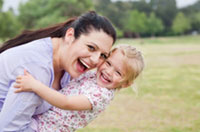Our children, teens and young adults information is currently under review. For cancer information and support, please contact our cancer nurses on 13 11 20. For information relating to paediatric cancer types, treatment and care, see The Royal Children’s Hospital and the Paediatric Integrated Cancer Services (PICS) websites, or speak with your doctor.
Cancer Council’s research commitment to childhood cancers
- Over the 5 year period 2013-2017, Cancer Council’s collectively invested $10m discretely in cancer research specifically identified as ‘children’s cancer’.
- Over the 5 year period 2013-2017, Cancer Councils collectively invested $13.5m in research studies and projects targeted at leukaemia across all ages.
- Over the 5 year period 2013-2017, Cancer Councils collectively invested over $216m in studies and projects that benefit multiple cancer types, including children’s cancers.
Key facts and figures
[1]
The below facts and figures have been provided by The Australian Childhood Cancer Registry, one of only a few complete national databanks for childhood cancer in the world.
The Australian Childhood Cancer Registry (ACCR) is funded and has been managed by Cancer Council Queensland since 2004.
For the past three decades, the ACCR has been the only source of complete, population-wide information on childhood cancer in Australia for researchers, clinicians and affected families.
The ACCR provides a unique, high-quality database of diagnostic, clinical and treatment information on every case of childhood cancer diagnosed in Australia and uses the data to report national incidence, mortality, survival and trends over time.
The Registry provides the foundation for research into this rare but significant disease; it enables national dissemination of information about childhood cancer; and it facilitates national and international collaborative research to improve outcomes of childhood cancer in Australia.
Childhood Cancer Incidence
- It is estimated that, on average, about 750 children aged 0-14 years old are diagnosed with cancer each year in Australia.
- Leukaemias are the most common type of cancer diagnosed among Australian children, accounting for around one third (33%) of all cases, followed by tumours of the central nervous system (mainly brain tumours) which were responsible for 25% of all diagnoses and lymphomas which accounted for a further 10%.
- Almost half (48%) of all children diagnosed with cancer in Australia were aged 0-4 years old at diagnosis, with a median age of 5 years.
- After adjusting for changes in the population, the incidence rate of all childhood cancers combined in Australia has increased significantly by a total of 35% between 1983 and 2014.
- Australia is estimated to have the fifth highest incidence rate of childhood cancers among countries in the G20, following Germany, the United States, South Korea and Canada. [2]
Childhood Cancer Survival
- Five-year relative survival for all children diagnosed with cancer in Australia between 2003 and 2012 was 84%. This is equal to or better than recent survival estimates from throughout North America and Europe. For example, the latest overall 5-year survival reported was 84% in Germany, 83% in the United States and Canada, 82% in the United Kingdom and 81% in the Netherlands.
- Five-year relative survival for all childhood cancers combined improved from 79% for children diagnosed between 1983-1992 to 84% for those diagnosed between 2003-2012.
- Very large improvements in survival have occurred for the diagnostic groups of leukaemias, lymphomas, neuroblastoma and malignant bone tumours. There has been little or no improvement in survival for several other types of childhood cancer over recent decades, particularly hepatic tumours.
Childhood Cancer Mortality
- There is an average of 101 cancer deaths per year for children under the age of 15 in Australia.
- Tumours of the central nervous system (mainly brain tumours) account for the largest number of cancer deaths for children in Australia (39%), followed by leukaemias (22%) and neuroblastoma (13%).
- Overall childhood cancer mortality rates decreased by an average of 3% per year between 1998 and 2014, or a total decrease of 39%.
- Australia is estimated to have the lowest childhood cancer mortality rate among all G20 countries. [3]

Supportive care services for children, adults and young adolescents (AYA) and their families
- Cancer Council 13 11 20 is equipped to provide specialist cancer information and support services related to childhood cancers. Of the 55,000 calls received per year Australia wide, over 850 enquiries per year pertain specifically to childhood cancer enquiries.
- Online peer support groups are available nationwide for children, adolescents, siblings and families, either conducted by Cancer Council’s or referred to other specialist childhood cancer organisations.
- One of Cancer Councils key written documents Talking to Kids about Cancer is available nationwide. More than 11,000 copies have been distributed. Additionally, around 1,000 copies were downloaded in 2016.
- Cancer in the School Community , an additional key evidence based written document is available nationwide. Over 4,500 copies were distributed, while over 370 copies were downloaded in 2016.
- Free wig services are offered for children affected by cancer related hair loss.
- Financial Assistance Services (FAS) are available for families affected by cancer. This includes a one-off grant to families or carers experiencing financial hardship following a cancer diagnosis of a child or AYA to cover everyday costs such as buying groceries or paying a phone bill. FAS also provide funding for children travelling interstate for treatment.
- The Holiday Break Program, available in Victoria, provides families with a one-off short getaway, at no cost that provides quality time with loved ones and a break from hospital visits and cancer treatment.
[1] Data Source: Australian Childhood Cancer Registry , CCQLD, Nov 2017
[2] Source: Globocan 2012
[3] Source: Globocan 2012